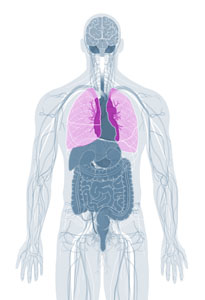 The respiratory system starts with the nose, nasal cavities, paranasal sinuses, nasopharynx, and larynx. It continues with a conducting segment (trachea and bronchi) that enters the lungs. transitional segment made up of respiratory bronchioles and primary, secondary, and tertiary bronchioles moves air deep into the lungs. An exchange segment made up of alveolar duct, atrium, alveolar sac, and alveolus passes oxygen into the blood and carbon dioxide and water out of the blood. In summary, the lungs place oxygen from the air into the blood and send carbon dioxide and water back into the air. The respiratory tract also warms and moistens the incoming air, regulates air flow, removes airborne particles, and cools the entire organism.
The respiratory system starts with the nose, nasal cavities, paranasal sinuses, nasopharynx, and larynx. It continues with a conducting segment (trachea and bronchi) that enters the lungs. transitional segment made up of respiratory bronchioles and primary, secondary, and tertiary bronchioles moves air deep into the lungs. An exchange segment made up of alveolar duct, atrium, alveolar sac, and alveolus passes oxygen into the blood and carbon dioxide and water out of the blood. In summary, the lungs place oxygen from the air into the blood and send carbon dioxide and water back into the air. The respiratory tract also warms and moistens the incoming air, regulates air flow, removes airborne particles, and cools the entire organism.
Click on a substance to go to the health effects chapter in the toxicological profile. Then, search on any target organ system to find the health effects information on that system.